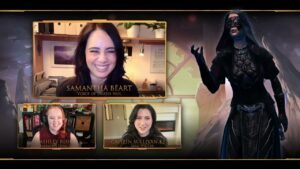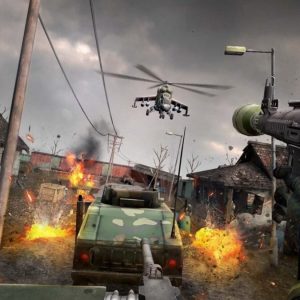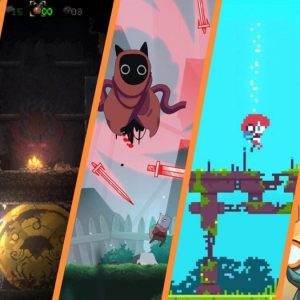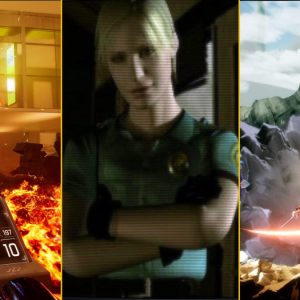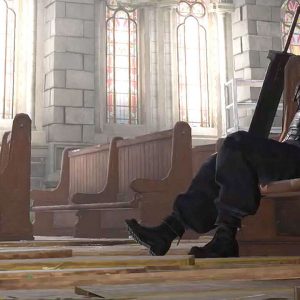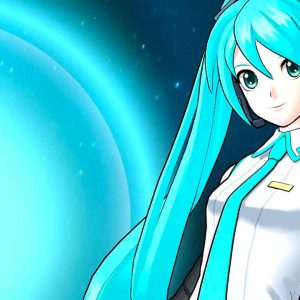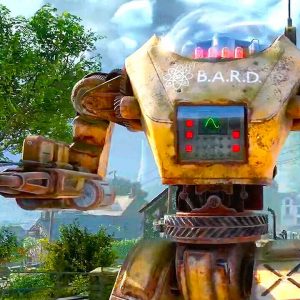Horror means different things to different people. Some people hate clowns. Some are troubled by the unknown of a dark space under the bed. And some (my old flatmate) will run away if a wooden spoon gets too close to brushing against their skin. The same broad range of fears can be found in video games as well. Sure, there are jumpy moments in The Last of Us Part 2, and Bloodborne’s Yharnam is dressed to the nines in gothic horror, but here we’re looking at those entirely scary experiences – those games that chill us to the core and are purely horrific, yet brilliant. With an emphasis placed on what we find the scariest, here are the 25 best horror games of all time.
25. Stay Out of the House
In recent years, many have attempted to capture the nostalgic, yet deeply unsettling aesthetic of analogue horror – a subgenre centred around turn-of-the-millennium tech and found footage – but none do it quite as well as developer Puppet Combo. With a library of over 20 developed and published games, there’s no shortage of gory and intense homages to the era of the VHS or PS1 to choose from, but Stay Out of the House is the standout entry of the one-man studio’s work. A mix of immersive sim and survival horror, you’re put to the test as you attempt to escape the disgusting lair of a cannibal butcher.
You have three days to plan your escape: will you scramble for a weapon?; set the serial killer’s traps against him?; or maybe help other survivors? All of these are viable options but unfortunately for you, the killer will adapt to all of them, barricading once-unlocked rooms, hiding items, and more, all to offer you an unforgettable CRT-filtered nightmare.
24. Slender: The Eight Pages
Who knew that in 2012 a simple sentence like “Collect all 8 pages” would leave such a lasting imprint on the imagination of all those who read it?
Inspired by the success of its creepypasta’s namesake, Slender: The Eight Pages arms you with just a flashlight and tasks you with sneaking through a park at night to collect a series of increasingly creepy notes. Sounds easy, until you realise you need to stay one step ahead of the “Slender Man” – a tall, faceless, tuxedo-wearing terror that stalks you throughout the ten or so minutes it’ll (hopefully) take you to escape. It’s simple but effective, and its stalking threat stays with you far longer than it takes to play.
23. The Evil Within
Resident Evil creator Shinji Mikami’s return to survival horror came in 2014 with The Evil Within, and its warped world didn’t disappoint. The Evil Within offers challenging gameplay, limited resources, an engaging story, and brilliantly horrific enemy design – The Keeper, Laura, Zehn, and Neun, to name just a few that have haunted one or two of our nightmares since.
This wickedly creative, tense, and yes, tough game does not suffer fools gladly, yet you’d be an even greater one not to give it a chance. We may have seen that bleeding game over the screen a few more times than we’d like, but it never made us not want to jump straight back in. That is the definition of great survival horror.
See our review of The Evil Within.
22. Condemned: Criminal Origins
Condemned: Criminal Origins – in which you take on the role of an FBI agent framed for murder – is an unforgettable journey through a grimy metropolis. Combining survival horror action with detective work, it builds a great sense of atmosphere that always makes you feel on edge and uncomfortable, and that’s the best part about it. Even if you’re squeamish, we recommend you play this alone at night with all the lights off, even if it’s just once, to fully appreciate just how frightening it really is.
21. Manhunt
While many games on this list have you playing an unwilling victim of horrors, Manhunt stands out by making you the architect (albeit under slight duress) of the terror. Hot on the heels of the worldwide success of Grand Theft Auto 3 and Vice City, Rockstar surprised the world by choosing to take its controversial games to the next level.
James Earl Cash, a criminal sentenced to death row for crimes too heinous to mention, is given a second chance in the form of a “starring” role in a mysterious director’s snuff film. Bloody, violent, and questionably sick, Manhunt is M-rated for a reason, and that’s largely because of its graphic depictions of murder. Death by crowbar to the face, wire chokes, and machete hackings are just some of the gruesome things you’ll see.
You may have seen this kind of thing in movies, anime, and the like, but no video game at that point (or arguably since) had gone as far as Rockstar’s Manhunt.
20. Inside
Anyone who’s played Inside always wants to talk about the ending. That’s perfectly understandable, Inside has one of the finest finales of any game of the past 15 years. But the focus on those final minutes means attention is drawn away from the real treat that’s the three or four hours prior.
Inside is a side-scroller dripping with an oppressive, unsettling atmosphere. Playing as a young boy in a world filled with ever-increasing danger, you must solve elegantly designed puzzles and escape all sorts of horrors as you push onward. It’s the fear of the unknown that keeps tensions high. As you gain the ability to control others and put them to work in the game’s best conundrums, Inside’s incredible art direction really comes alive, showcasing a dark, twisted world where humanity has been reduced to faceless shadows of their former selves. It’s unforgettable stuff.
19. Visage
When Konami cancelled Silent Hills in 2015, a slew of spiritual successors and games heavily influenced by the playable teaser came out. This includes Sad Square Studios’ first psychological horror, Visage. Set in the 1980s, you play Dwayne Anderson, a resident of a large home tormented by the supernatural, as he tries to find a way out and learn more about what is causing the paranormal activity.
As you explore the dark and eerily silent house, entities taunt you by breaking light bulbs, turning on and off lights, and slamming doors. This constant barrage of sensory terror, combined with the pressure to maintain Dwayne’s sanity, makes Visage one of the more challenging horror games released in recent years. It’s very much trial-and-error, but your patience is rewarded with a fascinating story and plenty of jump scares. While it may not be Silent Hills, the legacy of Konami’s unreleased game courses through the veins of Visage while also successfully establishing its own identity.
18. Phasmophobia
Phasmophobia came onto the scene like a bat out of hell. Four players join together as amateur ghost hunters, armed with tools like night-vision cameras, holy water, and radios. Wander through haunted homes and abandoned prisons, calling out for spirits from the beyond, as you gather clues in an attempt to successfully identify what kind of ghost is haunting your location.
As the clock ticks the chances of running into a ghost increase, and so does the danger. Nothing beats that moment when you suddenly see your friend twist and contort after being caught by one of Phasmophobia’s many evil spirits, as you desperately scramble to the exit for a hasty escape. As scary as it is, it also delivers laughs in equal measure, eliciting those involuntary emotions only horror and comedy can provide.
17. Dead by Daylight
Dead By Daylight launched in 2016 as a meagre but well-meaning asymmetrical slasher horror game where various bumbling teenagers avoided gnarly eviscerations from archetypal slasher movie villains. By 2021, it had become the Super Smash Bros. of horror games. Bringing in iconic killer characters from the movies like Freddy Kreuger and Michael Myers to legendary horror game villains like Resident Evil’s Nemesis and Silent Hill’s Pyramid Head, Dead By Daylight continues to evolve on its premise, routinely adding new characters, features, and more to its rock-solid foundation.
One thing remains constant, though: it’s just as fun to play the game as a group of seemingly helpless survivors in one round as it is to play as a huge, powerful, horror movie monster in the next. It’s deservedly established itself as the best in its field.
See our review for Dead By Daylight.
16. Until Dawn
Until Dawn possesses all the best (and worst) qualities of a B-grade horror movie: camp, gore, death, interpersonal tension, cheesy dialogue, a predictable plot, and liberal use of jump scares. Its game world – the Blackwood Mountain lodge – is relatively small, but developer Supermassive made it as entertainingly hostile as possible. This bitter landscape is captured with a keen eye on isolation, and Until Dawn does a great job of encouraging the sense that you’re always being watched as the teens split off from one another both physically and emotionally.
Until Dawn is a gleefully cheesy homage to slasher movies, set in a world built by a developer who clearly adores the genre. Its (often replicated) robust choice-and-consequence system was been genre-defining and allows players to truly experiment with the gruesome horrors hidden beneath its corny surface.
See our review for Until Dawn.
15. Alan Wake 2
Taking cues from the likes of David Lynch, Stephen King, and David Fincher, Alan Wake 2 is a deeply cinematic dive into the surreal. It’s a game of two halves and follows the intertwined journeys of titular writer Alan Wake and FBI agent Saga Anderson. In Alan’s chapters, you’ll blast ghostly figures and solve Resident Evil-esque puzzles in a nightmare version of New York City. But the further you venture, the stranger things get; you’ll write new pathways through reality, witness a bizarre Finnish horror movie, endure an anxiety-inducing chat show, and take part in the best rock opera you’ve ever gunned your way through.
Things are more grounded but similarly mechanically fascinating when taking control of Saga. Her chapters see the story transform into a blend of Hannibal and Zodiac, with Silent Hill-like exploration and combat sitting neatly next to police procedural work. As you investigate a chilling chain of ritual murders, you’ll need to arrange clues on your evidence board and drill deeper into the minds of your many suspects. This all adds up to a deeply ambitious, frequently disturbing experience, but one that’s never afraid of derailing the tension to deliver an unexpected comedy punchline.
See our review for Alan Wake 2.
14. Soma
‘Elevated horror’ has become an important part of spooky cinema over the past decade, combining chilling scares with artistic direction that explores ambitious topics or lofty subject matter. This approach is much rarer in games, but Soma is undoubtedly one of the subgenre’s shining interactive examples. Set in a decaying underwater research facility, it navigates themes of identity, consciousness, and the role of artificial intelligence while also subjecting you to nail-biting stealth horror situations.
Soma sees developer Frictional Games return to the playbook it established in its prior game, Amnesia: The Dark Descent, and so this is a non-combative experience with an emphasis on avoiding danger at all costs. Progressing deeper into its dread-filled narrative comes only via careful exploration of the facility’s barnacle-encrusted corridors and completion of puzzles, with each one unlocking new areas and even more chilling monsters to hide from. For frights with an even helping of thought, this is the ocean floor trip for you.
13. Clock Tower
Despite never being released outside of Japan, Clock Tower is a 16-bit survival horror classic that deserves its place on this list thanks to its pioneering stalker-psychopath gameplay. Jennifer is a teenage orphan stranded in a Resident Evil-like manor and she’s tasked with point-and-clicking through its impressively detailed, oppressive world. Worst still, she has to avoid the dreaded “Scissorman” who much like Mr. X, Nemesis, and Pyramid Head, is a near-unstoppable force who is always lurking nearby. With multiple endings to experience, you’ll certainly have reason to replay this horror time and again.
See our review for Clock Tower.
12. Forbidden Siren 2
The PlayStation 2 was home to many giants of the survival horror genre, thanks to the likes of Resident Evil 4, Silent Hill 2, and even Fatal Frame. But equally scary classic that’s less well known is Forbidden Siren 2. The story follows a group of stranded survivors on a remote Japanese island in 1976. Exploiting the best J-horror tropes, this episodic-style mystery has a steep learning curve: trying to master the unique ‘sight jacking’ ability – which lets you peer through the eyes of both friends and foes to navigate its rain-soaked levels – it tricky, but once mastered, you’re left with a refreshingly unique horror experience.
11. Resident Evil
It’s hard to imagine what horror in video games would look like without the arrival of Resident Evil. The first in the long-running (and extremely successful) series arrived in 1996, letting players explore the zombie-infested, puzzle-riddled Spencer Mansion, and it’s fair to say the survival horror genre hasn’t looked back since.
Although primitive by today’s standards, Resident Evil set the mould for everything that followed. The isolation, the limited resources, the relentless sense of dread, and jump scares… These are all things Resident Evil pioneered in video games, and without it the survival horror genre simply wouldn’t exist. Yes, Clock Tower outlined the blueprint, but Resident Evil masterfully executed the ideas and propelled survival horror to the masses.
Of course, the formula has since been regularly improved upon and the original is arguably weaker than most of its sequels. But none of it would have been possible without the progenitor and its importance to the genre is unquestionable.
See our review of Resident Evil.
10. Five Nights at Freddy’s
There was always something inherently creepy about being in a Chuck E. Cheese restaurant as a kid, a dimly lit, rat-themed birthday party center with sad pizza, a mostly broken arcade room, and a giant animatronic animal band that would shut down in between songs to stare into the souls of children with giant, dead-eyed looks. Five Nights at Freddy’s is an entire game about the fleeting joy and haunted magic of a seemingly lifeless collection of animatronic pizza restaurant mascots who suddenly spring to life and become horrifying nightmares, although instead of being a kid at a birthday party, you’re an employee tasked with watching the restaurant after dark and surviving the night yourself.
You’ll flip through security cameras and other various devices while unsettling mechanical faces pop up sporadically or generally go bump in the night, but what makes it all so unique is that Five Nights at Freddy’s is one of the few horror games that most kids can play without enduring a lifetime of trauma. It’s rare to have a game series that can cater to both young and adult horror fans, but it’s mostly because it features a thing we can all agree on: animatronic animals are terrifying.
9. Resident Evil 4
By the time Resident Evil 4 rolled around the played-out formula of the series was in need of a reinvention. Not only did Resident Evil 4 shatter expectations, it quickly became recognised as one of the greatest games of all time.
Resident Evil 4 once again puts you in the shoes of Leon S. Kennedy, who is in rural Spain to rescue the president’s daughter. But that plot quickly thickens as he gets tangled up in a story in which a new deadly virus threatens to sweep the world.
Although its scares are a touch lighter compared to its predecessors, Resident Evil 4 still packed a punch thanks to its lightning fast zombies (called Ganados) and chainsaw-wielding maniacs, who were never too far behind.
On any Best Of list, Resident Evil 4 would likely fare higher. But judged purely as a horror game, it takes a slight step backwards compared to the previous three games, opting for a more gung-ho, action approach. It’s nevertheless still a fantastic horror game, even if it does focus more on roundhouse kicks than jump scares.
See our review of Resident Evil 4.
8. Left 4 Dead 2
Before asynchronous multiplayer became the new horror trend, there was Valve’s co-op zombie slaughterhouse. As the title suggests, each mission of Left 4 Dead sees four players stranded in a quarantine zone and the group will only make it out alive if they work together to overcome the undead hordes. Both the original and its sequel are fantastic, but we’re going for Left for Dead 2 here, which improved on the formula in pretty much every aspect.
Left 4 Dead’s enduring appeal lies in its smart AI director, which finds new ways to deploy zombies and generate scares in every match. This random lottery keeps things unpredictable even if you’ve played the map in question 70 times already. Maybe it’ll surprise you with an unexpected Boomer, which explodes into a fountain of green goo that baits other infected. Or perhaps it’ll throw a Smoker into the fray, who can bind you with its meters-long tongue and drag you away from your allies. Or, if you’re really (un)lucky, the dice roll will result in a Witch; Left 4 Dead’s most frightful foe who, if disturbed, will unleash an extended rush of devastating, lightning-fast blows.
With snappy gunplay, fantastic level design, and a whole ‘80s horror franchise’s worth of blood ready to chuck all over the walls, Left 4 Dead 2 remains an eternal horror classic and one of the best zombie games of all time.
See our review of Left 4 Dead 2.
7. Outlast
With Outlast, developer Red Barrels took the found footage movie genre and expertly turned it into a five-hour interactive nightmare. Outlast gives players nothing in terms of defense; it’s a game of cat and mouse, where you’re the mouse and the cats are hyper-aggressive, disfigured patients at a supposedly abandoned psychiatric hospital.
Further, Outlast effectively turns sight into an in-game resource; the majority of the hospital is only visible through the green, grainy lens of your camera’s night vision, and that camera relies on batteries sparsely scattered throughout the building. When you can see what’s chasing you, Outlast is as scary as any game on this list. When the lights go out, it stands nearly in a league of its own.
6. Alien: Isolation
Ridley Scott’s 1979 sci-fi horror movie Alien is a masterclass in fear, building uneasy tension and suspense via the threat of its single, deadly extraterrestrial. On paper, it’s a concept not easily translated into video game form, but developer Creative Assembly absolutely nailed it with Alien: Isolation. Eschewing pulse rifles, gung-ho Colonial Marines, and gallons of acid blood in favour of stealth, creative solutions, and raw terror, Alien: Isolation demands that you outwit a single, indestructible xenomorph that stalks you around the sprawling Sevastopol space station.
Alien: Isolation is a first-class licensed game thanks to its unrivalled attention to detail when it comes to replicating the film’s universe; everything from computer interfaces and poster fonts to lighting and sound effects are authentic to the original movie’s visual style. But it’s the xenomorph, powered by sophisticated artificial intelligence, that truly makes Isolation a best-in-class Alien game. The beast quite literally has a mind of its own, capable of learning your tactics and finding new ways to hunt you. With only stealth, guts, and a few select tools to help you survive, Alien: Isolation is a terrifying horror simulator in a way few other games on this list are.
See our review of Alien: Isolation.
5. Dead Space
Resident Evil 4 redefined the survival horror genre, inspiring a slew of imitators to rapidly follow. But despite Dead Space wearing its Resident Evil 4 influence on its sleeve, it delivered a new level of intense horror that meant this sci-fi scarefest was a triumph in its own right.
As Isaac Clarke, you’re tasked with exploring a derelict spacecraft with terrore lurking around every corner. Its dimly lit corridors are littered with monstrosities from god-knows-where, and unfortunate crewmates mutilated into a disfigured mess. Dead Space personifies our fear of the unknown and graphically illustrates the deep space horrors we’d only ever really seen in the movies.
Necromorphs, the zombies of the series, are the epitome of terror and their gruesome designs and unpredictable nature made them a formidable foe. And unlike horror game enemies, a bullet to the brain won’t put them down so you need to learn the art of dismemberment instead.
Dead Space forces you to unlearn familiar habits then, and it made you feel vulnerable despite being armed to the teeth. But every gun in the universe isn’t enough to dampen Dead Space’s scare.
4. P.T
P.T. may not have been a full release and it’s no longer available to download, so we debated whether it should even be on this list. But the playable teaser – hence the name P.T. – is one of the scariest games ever made and as such, deserves recognition.
The result of a cross-industry, once-in-a-console-generation collaboration between acclaimed creators Hideo Kojima and Guillermo del Toro, P.T. was revealed via a nondescript teaser at Gamescom 2014, followed by an otherwise quiet release on the PlayStation Store. Hours later, the enigma was solved, and P.T. was revealed to be Silent Hills. But despite the code being cracked, the solution wasn’t entirely clear and P.T. would go on to become an obsession for players across the internet. Twitter, Reddit, Twitch, YouTube, NeoGAF, and other forums all attempted to piece together exactly how to reach its true ending.
Then there was the game itself, which was as terrifying as its reveal was fascinating. P.T. was set in a single, beautifully rendered looping hallway. Turning a corner remained as scary the first time as it was on the fifteenth. The subtle changes to the environment on each loop preyed on players’ expectations of familiarity and added disturbing life to a seemingly restricted play area. Of course, Silent Hills would never come to fruition with Konami officially cancelling the project a day after P.T. was removed from the PS Store. With that, the bizarre tale of one of the most terrifying games ever came to an end, but its legacy will always remain.
3. Amnesia: The Dark Descent
Are you afraid of the dark? Well, in Amnesia: The Dark Descent, it’s your best friend. Kind of. With gameplay mechanics that helped spur a rebirth of the survival horror genre that had drifted into action-game territory, modern horror games are indebted to Dark Descent.
Starting with the protagonist, Daniel, waking up alone in the dark castle of Brennenburg, he has no memory of how he got there, hence the name. As he explores his surroundings he realizes there’s a shadow stalking him, and wandering about the castle are other creatures that will give chase if they spot you. This wouldn’t be a huge problem if you could fight back, but the thing is, you just can’t. Your only defence is to run and often hide in the dark – a stark contrast to more action-oriented horror games like Resident Evil 5 which had come out the year before.
But here’s the kicker: stay in the dark too long and you’ll lose your mind. It’s not the first game to have a “sanity meter” (Eternal Darkness says hello), but its implementation in Amnesia is pretty ingenious. You’ll need to balance the game’s use of light to see what the hell you’re even doing with hiding in the darkness to avoid monsters, the same darkness that is slowly driving you insane.
Amnesia’s sequels and follow-ups all build upon The Dark Descent’s mechanics in smart ways, and other developers have taken notice, with Resident Evil 7’s decision to switch to a first-person perspective owing a lot to Amnesia’s success. The Dark Descent still holds up today, even if the controls and interface are a little rough on consoles, so if you’re in the mood to sit in the dark for 10 hours, take a trip to Brennenburg. Just don’t stay in the dark too long.
See our review for Amnesia: The Dark Descent.
2. Resident Evil 2 (2019)
There are many contenders for best entry in the Resident Evil series, but our vote, emphatically, goes to the 2019 remake of Resident Evil 2, which also happens to be the spookiest in a long line of quality RE spookies.
The original Resident Evil 2 took everything successful about the survival horror formula established by its older brother and refined it. The locations were creepier, the enemies more menacing – this was the introduction of the infamous Licker and Mr. X – and the scares were bigger and badder. The adventures of Leon and Claire in Raccoon City not only became a benchmark for Resident Evil but for the genre as a whole (until our next entry came along a few years later).
In every way that 1998’s Resident Evil 2 improved on its predecessor, the remake also replicated in kind. It’s a prime example of how to take an older game and reanimate it for a new generation of players. Pioneering a new generation of scares that are often imitated, but rarely equaled, Resident Evil 2 sits atop the pile when it comes to the genre’s most famous series.
See our review for Resident Evil 2.
1. Silent Hill 2
When it comes to representing real terror and its consequences, it doesn’t get any scarier than Silent Hill 2. It’s an increasingly disturbing and psychological journey into the repressed thoughts of its unassuming protagonist, and the tortured souls he meets along the way. Emotional tragedy, guilt, anger, abuse, and the horrible ways the resulting trauma manifests are handled with a grace and maturity that only strengthens Silent Hill 2’s disturbing subject matter. The mounting feeling that you are fleeing from an inescapable mistake, all leading up to the haunting revelation at the end and a devastating fight against one of video gaming’s most menacing antagonists, makes Silent Hill 2 the scariest game of all time.
The original Silent Hill 2 is perhaps the bleakest, most sombre game ever made and Bloober Team has successfully recreated its miserable magic, ensuring the remake is a deeply effective descent into genuinely uncomfortable terror. With the 2024 remake, Team Silent’s nightmarish vision is preserved. It’s a modern reminder not just of an era where Konami was a master of survival horror, but also of the significant power of Silent Hill 2’s unrelenting misery.
There’s just something about that PS2 version, though, that keeps us coming back to its slightly pixelated fog and uniquely haunting atmosphere. It’s fair to say that we’ve been seeing that restless town in our dreams ever since we first stepped foot in it back in 2001. 23 years later, nothing has been more terrifying.
See our review for Silent Hill 2.




